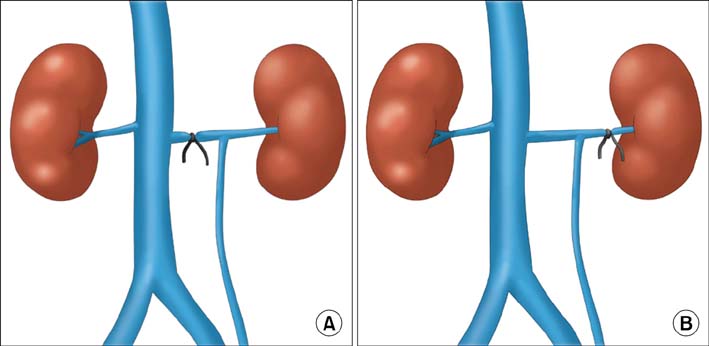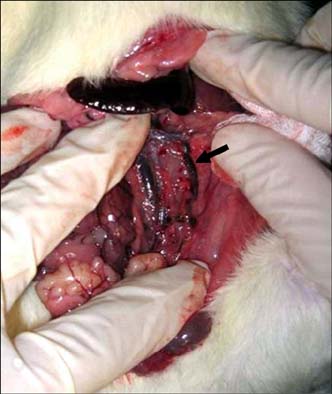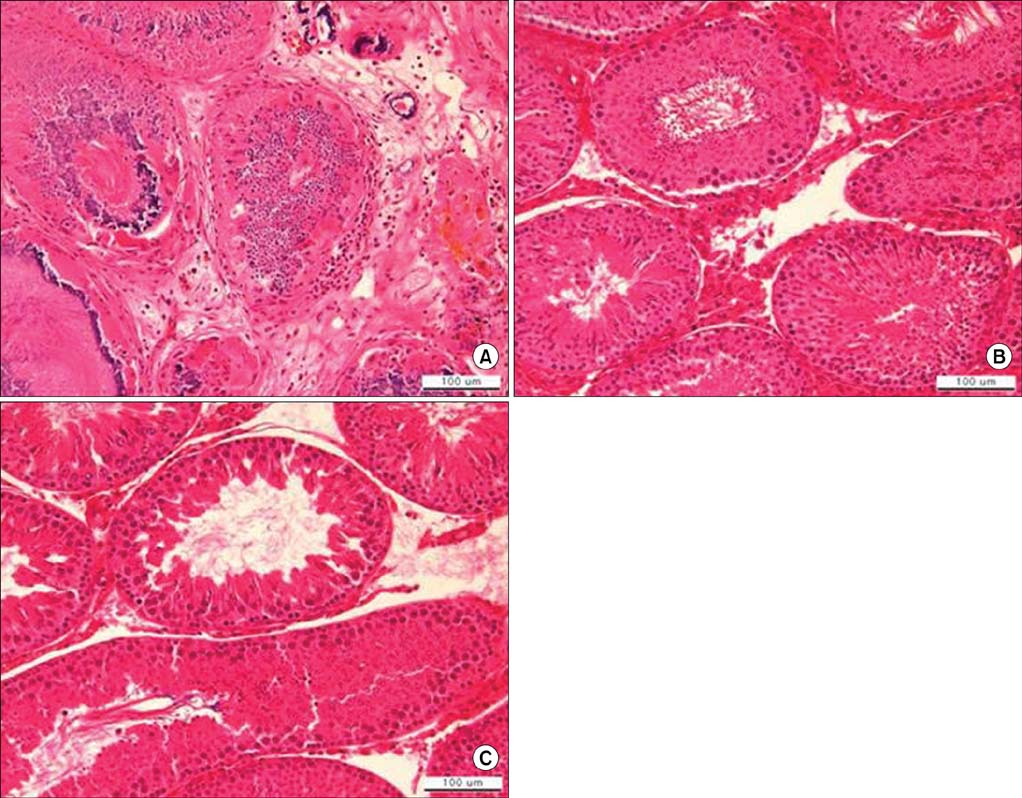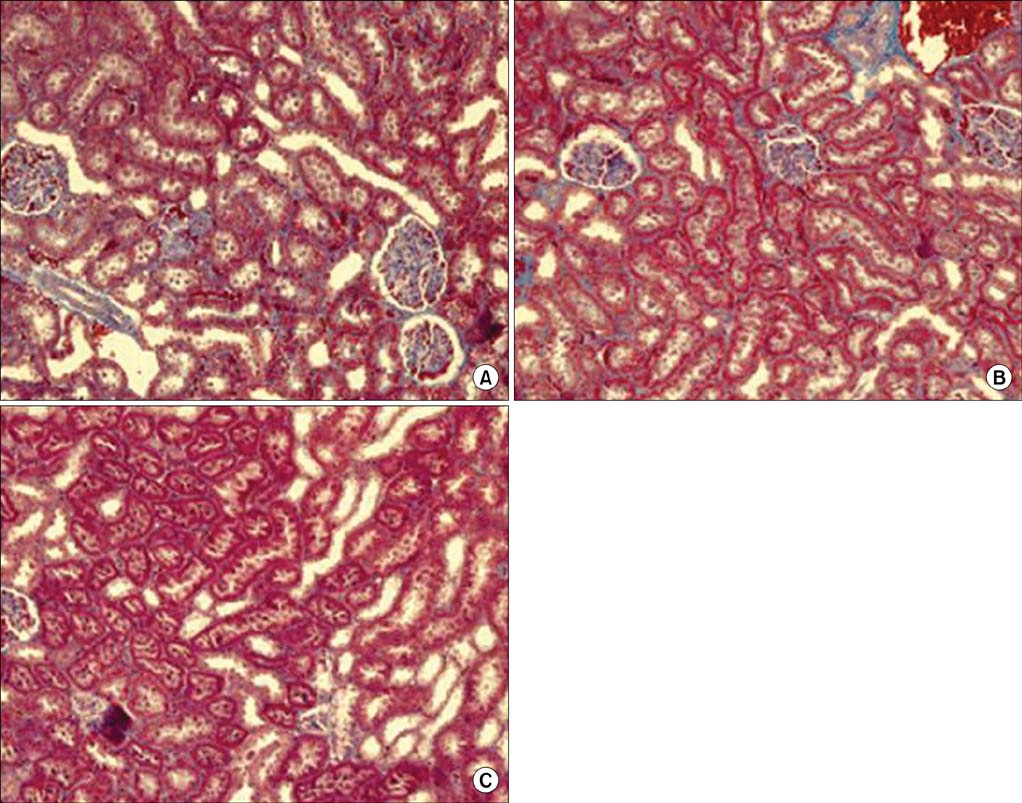Korean J Urol.
2010 Aug;51(8):565-571. 10.4111/kju.2010.51.8.565.
The Effect of the Partial Obstruction Site of the Renal Vein on Testis and Kidney in Rats: Is the Traditional Animal Model Suitable for Varicocele Research?
- Affiliations
-
- 1Department of Urology, Korea University College of Medicine, Seoul, Korea. jaeyoungpark@korea.ac.kr
- 2Department of Urology, Seoul National University College of Medicine, Seoul, Korea.
- KMID: 1997026
- DOI: http://doi.org/10.4111/kju.2010.51.8.565
Abstract
- PURPOSE
We investigated the influence of the location of the partial renal vein obstruction on the left kidney, the bilateral testes, and cauda epididymal sperm quality and determined whether this animal model is suitable for varicocele study.
MATERIALS AND METHODS
A total of 25 adult male Sprague-Dawley rats were assigned to three groups: group 1 (experimental varicocele by partial ligation medial to the internal spermatic vein for 8 weeks, n=8), group 2 (partial ligation lateral to the internal spermatic vein for 8 weeks, n=10), and group 3 (sham operation for 8 weeks, n=7). Rats in groups 1, 2, and 3 underwent a left nephrectomy and bilateral orchiectomy at 8 weeks after the operation. Histological changes and Johnsen score in both testes were analyzed. Fibrotic changes in the left kidney were assessed by quantitative image analysis. Numbers of sperm and proportions of motile sperm in the cauda epididymides were determined.
RESULTS
Significant histological abnormalities and Johnsen score changes were observed in the testes in group 1. Renal fibrosis did not differ significantly among the groups. The proportions of motile sperm were significantly lower bilaterally in group 1 than in groups 2 and 3. However, the mean bilateral epididymal sperm count in group 1 was not significantly lower than in groups 2 and 3.
CONCLUSIONS
Our results showed that experimental varicocele in the rat, induced by partial ligation medial to the internal spermatic vein, influences epididymal sperm quality without harmful effects on the left kidney. The present study certifies that this traditional animal model is suitable for varicocele research.
Keyword
MeSH Terms
Figure
Reference
-
1. Choi H, Kim KS, Kim KM. The effect of experimental varicocele on the testis of adolescent rats. J Urol. 1990. 144:499–501.2. Steeno O, Knops J, Declerck L, Adimoelja A, van de Voorde H. Prevention of fertility disorders by detection and treatment of varicocele at school and college age. Andrologia. 1976. 8:47–53.3. Skoog SJ, Roberts KP, Goldstein M, Pryor JL. The adolescent varicocele: what's new with an old problem in young patients? Pediatrics. 1997. 100:112–121.4. Kim KS, Choi H. The effects of experimental varicocele on testis in adolescent rats. Korean J Urol. 1989. 30:19–28.5. Kay R, Alexander NJ, Baugham WL. Induced varicoceles in rhesus monkeys. Fertil Steril. 1979. 31:195–199.6. Al-Juburi A, Pranikoff K, Dougherty KA, Urry RL, Cockett AT. Alteration of semen quality in dogs after creation of varicocele. Urology. 1979. 13:535–539.7. Simsek F, Türkeri L, Cevik I, Bircan K, Akdas A. Role of apoptosis in testicular tissue damage caused by varicocele. Arch Esp Urol. 1998. 51:947–950.8. Wang GL, Jiang BH, Rue EA, Semenza GL. Hypoxia-inducible factor 1 is a basic-helix-loop-helix-PAS heterodimer regulated by cellular O2 tension. Proc Natl Acad Sci USA. 1995. 92:5510–5514.9. Vukovic V, Haugland HK, Nicklee T, Morrison AJ, Hedley DW. Hypoxia-inducible factor-1alpha is an intrinsic marker for hypoxia in cervical cancer xenografts. Cancer Res. 2001. 61:7394–7398.10. Greenberg SH. Varicocele and male fertility. Fertil Steril. 1977. 28:699–706.11. Verstoppen GR, Steeno OP. Varicocele and the pathogenesis of the associated subfertility. A review of the various theories. III: Theories concerning the deleterious effects of varicocele on fertility. Andrologia. 1978. 10:85–102.12. Kilinc F, Kayaselcuk F, Aygun CM, Guvel S, Egilmez T, Ozkardes H. Experimental varicocele induces hypoxia inducible factor-1alpha, vascular endothelial growth factor expression and angiogenesis in the rat testis. J Urol. 2004. 172:1188–1191.13. Johnsen SG, Agger P. Quantitative evaluation of testicular biopsies before and after operation for varicocele. Fertil Steril. 1978. 29:58–63.14. Asci R, Sarikaya S, Büyükalpelli R, Yilmaz AF, Yildiz S. The effects of experimental varicocele on testicular histology and fertility in monorchic adult rats. BJU Int. 1999. 83:493–497.15. Raleigh D, O'Donnell L, Southwick GJ, de Kretser DM, McLachlan RI. Stereological analysis of the human testis after vasectomy indicates impairment of spermatogenic efficiency with increasing obstructive interval. Fertil Steril. 2004. 81:1595–1603.16. Kim SJ, Lee MS. Effect of Sertoli cell changes on germ cells in experimentally produced varicocele in rats. Korean J Urol. 1992. 33:404–417.17. Saypol DC, Howards SS, Turner TT, Miller ED Jr. Influence of surgically induced varicocele in testicular blood flow, temperature, and histology in adult rats and dogs. J Clin Invest. 1981. 68:39–45.18. Turner TT. The study of varicocele through the use of animal models. Hum Reprod Update. 2001. 7:78–84.19. Comhaire F, Vermeulen A. Varicocele sterility: cortisol and catecholamines. Fertil Steril. 1974. 25:88–95.20. Zhang H, Li M, Jin W, San P, Xu P, Pan S. The left renal entrapment syndrome: diagnosis and treatment. Ann Vasc Surg. 2007. 21:198–203.21. Takemura T, Iwasa H, Yamamoto S, Hino S, Fukushima K, Isokawa S, et al. Clinical and radiological features in four adolescents with nutcracker syndrome. Pediatr Nephrol. 2000. 14:1002–1005.22. Zorgniotti AW. Testis temperature, infertility, and the varicocele paradox. Urology. 1980. 16:7–10.23. Chakraborty J, Hikim AP, Jhunjhunwala JS. Stagnation of blood in the microcirculatory vessels in the testes of men with varicocele. J Androl. 1985. 6:117–126.24. Nahoum CR, Fontes EA, Freire FR. Semen analysis in sickle cell disease. Andrologia. 1980. 12:542–545.25. Oztürk H, Tander B, Aydin A, Okumus Z, Cetinkursun S. The effects of chemical sympathectomy on testicular injury in varicocele. BJU Int. 2001. 87:232–234.26. Cho WJ, Yeo MH, You HJ, Chang IY, Moon HY, Kim CS. The expression of p53 and phosphorylation of H2AX in germ cells of varicocele rats. Korean J Urol. 2006. 47:1354–1360.27. Seed J, Chapin RE, Clegg ED, Dostal LA, Foote RH, Hurtt ME, et al. Methods for assessing sperm motility, morphology, and counts in the rat, rabbit, and dog: a consensus report. Reprod Toxicol. 1996. 10:237–244.28. Linder RE, Strader LF, Slott VL, Suarez JD. Endpoints of spermatotoxicity in the rat after short duration exposures to fourteen reproductive toxicants. Reprod Toxicol. 1992. 6:491–505.29. Bechtel W, Zeisberg M. Twist: a new link from hypoxia to fibrosis. Kidney Int. 2009. 75:1255–1256.
- Full Text Links
- Actions
-
Cited
- CITED
-
- Close
- Share
- Similar articles
-
- The Effect of the Partial Obstruction Site of the Renal Vein on Testis and Kidney in Rats: Is the Traditional Animal Model Suitable for Varicocele Research?
- The Effect of Experimental Varicocele on Fertility in Adolescent Rats
- The Effects of Experimental Varicocele on Testis in Adolescent Rats
- Clinical Observation of Varicocele Using a Phlebography
- The Changes of Testis and the Effects of Anthocyanin on Spermatogenesis in Rat Induced Varicocele





